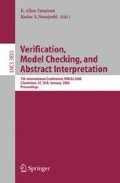Abstract
Program analysis commonly makes use of Boolean functions to express information about run-time states. Many important classes of Boolean functions used this way, such as the monotone functions and the Boolean Horn functions, have simple semantic characterisations. They also have well-known syntactic characterisations in terms of Boolean formulae, say, in conjunctive normal form. Here we are concerned with characterisations using binary decision diagrams. Over the last decade, ROBDDs have become popular as representations of Boolean functions, mainly for their algorithmic properties. Assuming ROBDDs as representation, we address the following problems: Given a function ψ and a class of functions Δ, how to find the strongest ϕεΔ entailed by ψ (when such a ϕ is known to exist)? How to find the weakest ϕεΔ that entails ψ? How to determine that a function ψ belongs to a class Δ? Answers are important, not only for several program analyses, but for other areas of computer science, where Boolean approximation is used. We give, for many commonly used classes Δ of Boolean functions, algorithms to approximate functions represented as ROBDDs, in the sense described above. The algorithms implement upper closure operators, familiar from abstract interpretation. They immediately lead to algorithms for deciding class membership.
Access this chapter
Tax calculation will be finalised at checkout
Purchases are for personal use only
Preview
Unable to display preview. Download preview PDF.
References
Armstrong, T., Marriott, K., Schachte, P., Søndergaard, H.: Two classes of Boolean functions for dependency analysis. Science of Computer Programming 31(1), 3–45 (1998)
Brace, K., Rudell, R., Bryant, R.: Efficient implementation of a BDD package. In: Proc. Twenty-seventh ACM/IEEE Design Automation Conf., pp. 40–45 (1990)
Bryant, R.: Graph-based algorithms for Boolean function manipulation. IEEE Trans. Computers C–35(8), 677–691 (1986)
Bryant, R.: Symbolic Boolean manipulation with ordered binary-decision diagrams. ACM Computing Surveys 24(3), 293–318 (1992)
Codish, M., Søndergaard, H., Stuckey, P.J.: Sharing and groundness dependencies in logic programs. ACM Transactions on Programming Languages and Systems 21(5), 948–976 (1999)
Cousot, P., Cousot, R.: Static determination of dynamic properties of recursive procedures. In: Neuhold, E.J. (ed.) Formal Description of Programming Concepts, pp. 237–277. North-Holland, Amsterdam (1978)
Cousot, P., Cousot, R.: Systematic design of program analysis frameworks. In: Proc. Sixth ACM Symp. Principles of Programming Languages, pp. 269–282. ACM Press, New York (1979)
Ekin, O., Foldes, S., Hammer, P.L., Hellerstein, L.: Equational characterizations of Boolean function classes. Discrete Mathematics 211, 27–51 (2000)
Genaim, S., King, A.: Goal-independent suspension analysis for logic programs with dynamic scheduling. In: Degano, P. (ed.) ESOP 2003. LNCS, vol. 2618, pp. 84–98. Springer, Heidelberg (2003)
Giacobazzi, R.: Semantic Aspects of Logic Program Analysis. PhD thesis, University of Pisa, Italy (1993)
Giacobazzi, R., Scozzari, F.: A logical model for relational abstract domains. ACM Trans. Programming Languages and Systems 20(5), 1067–1109 (1998)
Glynn, K., Stuckey, P.J., Sulzmann, M., Søndergaard, H.: Exception analysis for non-strict languages. In: Proc. 2002 ACM SIGPLAN Int. Conf. Functional Programming, pp. 98–109. ACM Press, New York (2002)
Halmos, P.R.: Lectures on Boolean Algebras. Springer, Heidelberg (1963)
Heaton, A., Abo-Zaed, M., Codish, M., King, A.: A simple polynomial groundness analysis for logic programs. J. Logic Programming 45(1-3), 143–156 (2000)
Howe, J.M., King, A.: Efficient groundness analysis in Prolog. Theory and Practice of Logic Programming 3(1), 95–124 (2003)
Howe, J.M., King, A., Lu, L.: Analysing logic programs by reasoning backwards. In: Bruynooghe, M., Lau, K.-K. (eds.) Program Development in Computational Logic. LNCS, vol. 3049, pp. 152–188. Springer, Heidelberg (2004)
Marriott, K., Søndergaard, H.: Precise and efficient groundness analysis for logic programs. ACM Lett. Programming Languages and Systems 2(1–4), 181–196 (1993)
Mycroft, A.: Abstract Interpretation and Optimising Transformations for Applicative Programs. PhD thesis, University of Edinburgh, Scotland (1981)
Ore, O.: Combinations of closure relations. Ann. Math. 44(3), 514–533 (1943)
Post, E.L.: The Two-Valued Iterative Systems of Mathematical Logic. Princeton University Press, Princeton (1941); Reprinted in Davis, M.: Solvability, Provability, Definability: The Collected Works of Emil L. Post, pp. 249–374. Birkhaüser (1994)
Rudeanu, S.: Boolean Functions and Equations. North-Holland, Amsterdam (1974)
Schaefer, T.J.: The complexity of satisfiability problems. In: Proc. Tenth Ann. ACM Symp. Theory of Computing, pp. 216–226 (1978)
Ward, M.: The closure operators of a lattice. Ann. Math. 43(2), 191–196 (1942)
Author information
Authors and Affiliations
Editor information
Editors and Affiliations
Rights and permissions
Copyright information
© 2005 Springer-Verlag Berlin Heidelberg
About this paper
Cite this paper
Schachte, P., Søndergaard, H. (2005). Closure Operators for ROBDDs. In: Emerson, E.A., Namjoshi, K.S. (eds) Verification, Model Checking, and Abstract Interpretation. VMCAI 2006. Lecture Notes in Computer Science, vol 3855. Springer, Berlin, Heidelberg. https://doi.org/10.1007/11609773_1
Download citation
DOI: https://doi.org/10.1007/11609773_1
Publisher Name: Springer, Berlin, Heidelberg
Print ISBN: 978-3-540-31139-3
Online ISBN: 978-3-540-31622-0
eBook Packages: Computer ScienceComputer Science (R0)

